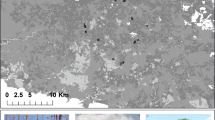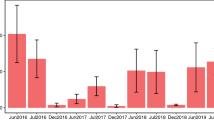Abstract
Native bees in Yucatán, México are treatened by agricultural land uses that limit their food resources, alter their reproductive habitats and increase their mortality. Various species may disappear before their importance for regional agricultural productivity and ecosystem maintenance is known. In order to assess their assemblage as visitors of cucurbit crops, we sampled more than 2000 bee specimens on fourteen fields of pumpkin, cucumber, melon and watermelon from five localities between 1995 and 1997; sample units consisted of all bees collected by net sweeping in a given field during 25–30 accumulated hours on separate days. The fourteen samples comprised bees of six families, 29 genera and 58 species. Composition per sample ranged between 10 and 27 species and abundance between 28 and 444 individuals. Seven species (six genera) of Apidae, Anthophoridae and Halictidae comprised around 80% of all the individuals collected. Yet, diversity measures indicated intermediate to high evenness in most sampled bee assemblages, i.e. despite the frequent abundance of some species of Augochlora, Partamona, Ceratina, Trigona or Peponapis, other bee visitors were also relatively important, particularly in small samples. Individual samples of pumpkin bee visitors had significantly different evenness among themselves and to other cucurbit crops. The percent similarity and number of shared species among the fourteen samples were both usually low; lumping data per crop and locality showed, however, higher evenness and more common species than individual samples. Results are discussed in terms of future research priorities: natural history of tropical native bees and strategies to monitor bee community changes for conservation purposes.
Similar content being viewed by others
References
Allen-Wardell G., Bernhard P., Bitner R., Búrquez A., Buchmann S., Cane J. et al. 1998. The potential consequences of pollinator declines on the conservation of biodiversity and stability of crop yields. Conservation Biology 12: 8–17.
Ayala R. 1992. Las abejas sin aguijón de México. MS thesis, UNAM, México.
Ayala R., Griswold T. and Bullock S. 1996. Apoidea (Hymenoptera). In: Llorente B.J., García-Aldrete A.N. and González E.S. (eds), Biodiversidad, Taxonomía y Biogeografía de Artrópodos de México: Hacia una síntesis de su conocimiento. CONABIO-UNAM, México, pp. 423–464.
Ayala R., Griswold T. and Bullock S. 1998. Las abejas nativas de México. In: Ramamoorthy T.P., Bye R., Lot A. and Fa J. (eds), Diversidad biológica de México: orígenes y distribución. IBUNAM, México, pp. 179–225.
Buchmann L.S. and Nabhan P.G. 1996. The Forgotten Pollinators. Island Press, USA.
Cane J.H. 2001. Habitat fragmentation and native bees: a premature verdict? Conservation Ecology 5: 3.
Cane J.H. and Tepedino V.J. 2001. Causes and extent of declines among native North American invertebrate pollinators: detection, evidence and consequences. Conservation Ecology 5: 1.
Canto-Aguilar A. and Parra-Tabla V. 2000. Importance of conserving alternative pollinators: assessing the pollination efficiency of the squash bee, Peponapis limitaris in Cucurbita moschata (Cucurbitaceae). Journal of Insect Conservation 4: 203–210.
Delfin H., Parra-Tabla V. and Echazarreta C. 1995. El Conocimiento y Manejo de las Selvas de la Península de Yucatán. UADY, Mer. Yuc., Mex.
Feinsinger P. 1987. Approaches to nectarivore-plant interactions in the New World. Revista Chilena de Historia Natural 60: 285–319.
Flores S. and Espejel C. 1994. Tipos de vegetación de la Península de Yucatán. Etnoflora Yucatanense 3: 1–135.
Free J.B. 1993. Insect pollination of crops. 2nd edn. Academic Press, London, UK.
García E. 1988. Modificaciones al sistema de clasificación climática de Köppen adaptado a las condiciones climáticas de México. Instituto de Geografía-UNAM, México.
Heithaus E.R. 1979. Community structure of neotropic flower visiting bees and wasps: diversity and phenology. Ecology 60: 190–202.
Hurd P.D. Jr, Linsley E.G. and Whitaker T.W. 1971. Squash and gourd bees (Peponapis, Xenoglossa) and the origin of the cultivated Cucurbita. Evolution 21: 218–234.
Kearns C.A. and Inouye D.W. 1997. Pollinators, flowering plants, and conservation biology. Bioscience 47: 297–307.
Kevan P.G. 1991. Pollination: keystone process in sustainable global productivity. Acta Horticulturae 288: 103–110.
Kevan P.G., Greco C.F. and Belaoussoff S. 1997. Biodiversity and abundance in diagnosis and measuring of ecosystem health: pesticide stress on pollinators on blueberry heaths. Journal of Applied Ecology 34: 1122–1136.
Kevan P. and Phillips T.P. 2001. The economic impacts of pollinator declines: an approach to assessing the consequences. Conservation Ecology 5: 8.
Krebs C.J. 1999. Ecological Methodology. Addison-Welsey Educational Publishers Inc, CA, USA.
Mayr E. and Ashlock P.D. 1991. Principles of Systematic Zoology. McGraw-Hill, USA.
McGregor S.E. 1976. Insect Pollination of Cultivated Crop Plants. Agriculture Hand Book. No. 496.
Meléndez R.V., Parra T.V., Echazarreta C.M. and Magaña R.S. 2000. Use of native bees and honeybees in horticultural crops of Cucurbita moschata in Yucatán, México. In: Munn P. (ed.), Proceedings of the 6th Conference on Tropical Bees: Management and Diversity. I.B.R.A., Cardiff, UK, pp. 65–70.
Michener C.D., McGinley R. and Danforth B.N. 1994. The Bee Genera of North America and Central America (Hymenoptera: Apoidea). Smithsonian Institution Press, Washington, DC, USA.
Nabhan G.P. and Buchman S.E. 1997. Services provided by pollinators. In: Daily G.C. (ed.), Nature's services: societal dependence on natural ecosystems. Island Press, Washington, pp. 133–150.
O'Toole C. 1993. Diversity of native bees and agroecosystems. In: La Salle J. and Gauld I.D. (eds), Hymenoptera and Biodiversity. CAB International, London, pp. 169–196.
Parra-Tabla V., Meléndez V., Contreras H. and Pinkus M. 1998. Efecto del uso de pesticidas en la riqueza y abundancia de abejas nativas asociadas a cultivos hortícolas en el estado de Yucatán, México. In: XXXIII Congreso Nacional de Entomología., Acapulco, México, pp. 203–206.
Parra-Tabla V., Vargas C., Magaña-Rueda S. and Navarro J. 2000. Female and male pollination success of Oncidium ascendens Lindey (Orchidaceae) in two contrasting habitat patches: forest vs agricultural field. Biological Conservation 94: 335–340.
Pascarella J.B., Waddington K.D. and Neal P.R. 1999. The Bee Fauna (Hymenoptera: Apoidea) of Everglades National Park, Florida and Adjacent Areas: Distribution, Phenology, and Biogeography. Journal of the Kansas Entomological Society 72: 32–45.
Peet R.K. 1974. The measurement of species diversity. Annual Review of Ecology and Systematics 5: 285–307.
Rohlf F. 1988. NTSYS-PC: Numerical Taxonomy and Multivariate Analysis System 1.50. Exeter Publishing, New York, USA.
Roubik D.W. 1989. Ecology and Natural History of Tropical Bees. Cambridge University Press, USA.
Roubik D.W. 1995. Pollination of Cultivated Plants in the Tropics. FAO 118: 1–197.
Roubik D.W. 2001. Ups and downs in pollinator populations: when is there a decline? Conservation Ecology 5: 2.
Roubik D.W. and Wolda H. 2001. Do competing honey bees matter? Dynamics and abundance of native bees before and after honey bee invasion. Population Ecology 43: 53–62.
Shrivastava U. 1990. Insect pollination in some cucurbits. In: 6th International Symposium on Pollination. ISHS, Tilburg, pp. 445–451.
Tepedino V. 1981. The pollination efficiency of squash bee (Peponapis pruinosa) and honey bee (Apis mellifera) on summer squash (Cucurbita pepo). Journal of Kansas Entomological Society 54: 359–377.
Willis D.S. and Kevan P.G. 1995. Foraging dynamics of Peponapis pruinosa (Hymenoptera: Anthophoridae) on pumpkin (Cucurbita pepo) in southern Ontario. The Canadian Entomologist 127: 167–175.
Zar J.H. 1984. Biostatistical analysis. Prentice-Hall.
Zizumbo V.D. 1992. Las calabazas del sistema milpero como recurso genético. In: Zizumbo V.D., Rassmussen C.H., Arias-Reyes L.M. and Terán-Contreras S. (eds), La modernización de la milpa en Yucatán: utopía o realidad. CICY-DANIDA, Yucatán, pp. 161–174.
Author information
Authors and Affiliations
Corresponding author
Rights and permissions
About this article
Cite this article
Meléndez-Ramirez, V., Magaña-Rueda, S., Parra-Tabla, V. et al. Diversity of native bee visitors of cucurbit crops (Cucurbitaceae) in Yucatán, México. Journal of Insect Conservation 6, 135–147 (2002). https://doi.org/10.1023/A:1023219920798
Issue Date:
DOI: https://doi.org/10.1023/A:1023219920798




